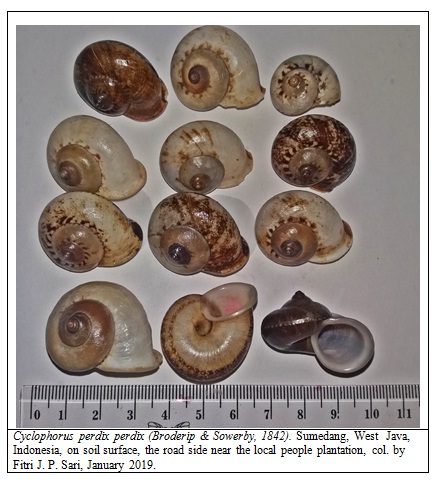They are Cyclophorus perdix perdix, one of land snail members. I found them around the road near the local people plantation in my village. Actually, Sumedang isn't located in karst area, so it's hard to find any land snails here, except Acathina fulica and this snail (Cyclophorus perdix perdix) found easily. The local people called it Tenggek.
They were found dead and i collected their shells. Actually, Cyclophorus perdix perdix has an operculum attached to their foot, but unfortunately, i didn't find it. Maybe, when they die, their bodies decay and the operculum separates.
Cyclophorus perdix perdix, salah satu anggota keong darat. Saya menemukan mereka di sekitar jalan dekat perkebunan warga di desa saya. Sebenarnya, Sumedang bukan wilayah kars, jadi sulit untuk menemukan keong darat, kecuali Acathina fulica dan keong ini (Cyclophorus perdix perdix). Orang-orang menyebut keong ini Tenggek
Mereka ditemukan dalam keaadan mati dan saya mengkoleksi cangkangnya. Sebenarnya, Cyclophorus perdix perdix mempunyai operkulum yang menempel di kakinya, tapi sayangnya saya tidak menemukannya. Mungkin ketika tubuh mereka membusuk, operkulumnya terpisah.
Classification/Klasifikasi
Kingdom
|
Animalia
|
Phylum
|
Mollusca
|
Classis
|
Gastropoda
|
Subclassis
|
Prosobranchia –
operculate land snail
|
Order
|
Mesogastropoda
|
Familia
|
Cyclophoridae
|
Genus
|
Cyclophorus
|
Species
|
Cyclophorus perdix perdix
|
Description/Deskripsi
It's included medium shell, which is its shell height about 24 mm. It has a strong shell but not too thick. Ground colour brownish. Shell low conical, and dextral. Umbilicus wide, aperture round, aperture lip (peristome) continuous. Whorls 5-6.
Cyclophorus perdix perdix termasuk keong yang berkuran sedang, yang mana tinggi cangkangnya lebih dari 20 mm. Cangkangnya keras tapi tidak tidak terlalu tebal. Warna dasarnya coklat. Bentuknya contong dan arah puratannya dekstral (ke kanan). Jenis pusarnya lebar, bentuk mulutnya bulat, tepi mulut cangkangnya menerus. Jumlah ulirnya 5-6.
Distribution/Distribusi
Java, Nusa Kambangan, Madura, Bali (1949)
Habitat/Habitat
Terrestrial/Darat
Behavioral/Tingkah laku
Nocturnal (active at night), but it's also can active after rain.
Nokturnal (aktif pada malam hari), tapi juga aktif setelah hujan.
Glossary
1. Shell Morphology/morfologi cangkang
(Perez, K.E. and Cordeiro, J.R. 2008)
(Heryanto, 2011)
2. Size/ukuran
(Heryanto, 2011)
3. Shell rotation/putaran cangkang
(Heryanto, 2011)
4. Whorls/uril
(Heryanto, 2003)
5. Peristome type/ tipe mulut cangkang
References
Heryanto, 2011. Land Snail of Java (Keong Darat Pulau Jawa: Panduan lapangan). Bogor: LIPI press.
Heryanto, M., Ristiyanti M., Munandar,
A., dan P., Susilowati. 2003. Keong dari
Taman Nasional Gunung Halimun: Sebuah
Buku Panduan Lapangan. Bogor: LIPI press.
Jutting, van Benthem.1948. Systematic studies on the Non-Marine Mollusca of the Indo-Australian Archipelago. Critical revision of the Javanese Operculate. Land-shells of families Hydrocenidade, Helicinidae, Chyclophorus, Pupinidae and Choclostomatidae. Treubia 19 (3).
Perez,
K.E. and Cordeiro, J.R. 2008. A guide for terrestrial Gastropod identification.
Proceedings of the Terrestrial Gastropod Identification Workshop. Southern
Illinois University, Carbondale, Illinois.
Sari, Fitri J. P. 2015. Keanekaragaman Genus Keong Darat di Kawasan Kars Sukolilo, Kabupaten Grobogan dan Kabupaten Pati, Jawa Tengah. Skripsi. Bandung: UIN Sunan Gunung Djati.








Comments
Post a Comment